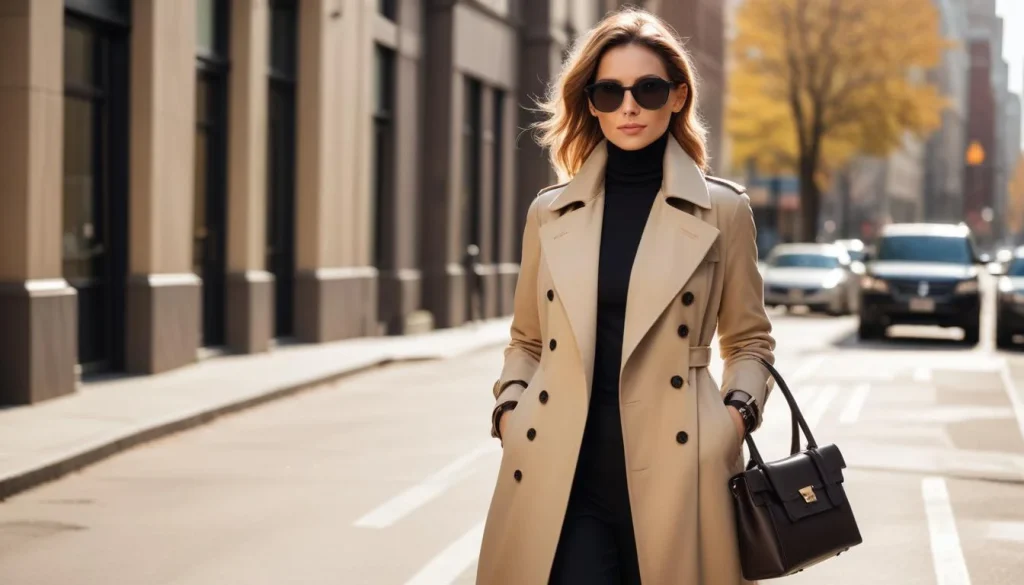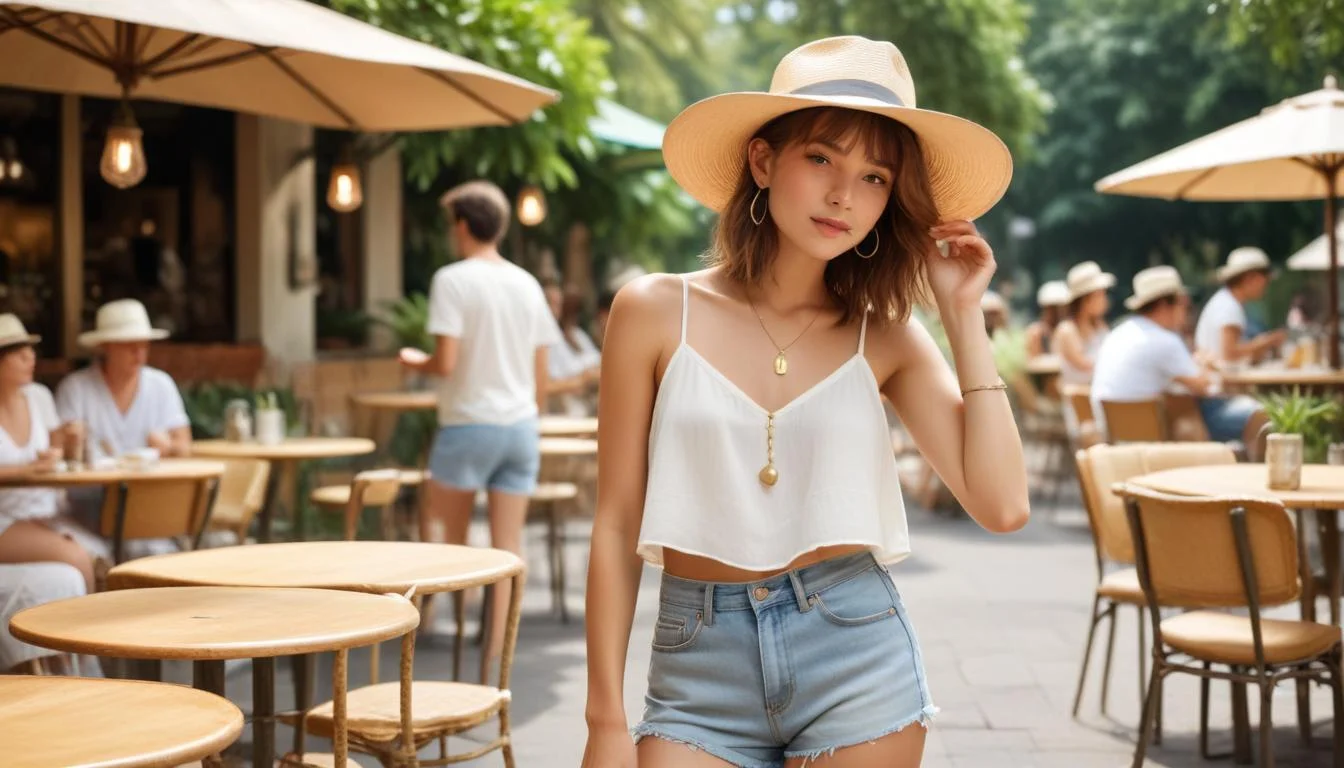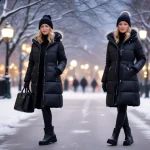Mastering Layering: Women’s Style Guide for All Seasons

Mastering the art of layering allows women to create versatile, stylish, and comfortable outfits for any season by strategically combining different garments and textures, adapting to changing temperatures and personal style.
Welcome to the ultimate guide on mastering the art of layering: women’s style guide for all seasons. Layering isn’t just about adding warmth; it’s a sophisticated technique that transforms basic outfits into dynamic, fashion-forward statements. Whether you’re navigating brisk autumn mornings, humid summer evenings, or chilly winter days, understanding how to layer effectively can elevate your wardrobe and ensure you’re prepared for any climate fluctuations.
The foundational principles of effective layering
Effective layering goes beyond simply piling on clothes. It’s an art that balances aesthetics with functionality, ensuring you look polished while staying comfortable. The key lies in understanding foundational principles that dictate how different garments interact with each other in terms of fabric, fit, and proportion. By adhering to these guidelines, you can create cohesive and stylish layered looks that adapt to any situation or season.
One of the primary tenets is starting with a thin, breathable base layer. This initial piece should be comfortable against your skin and ideally made from moisture-wicking materials in warmer climates or insulating fabrics in colder ones. The base layer sets the tone for the entire outfit, influencing both comfort and the overall silhouette. Without a proper base, subsequent layers might feel bulky or uncomfortable, undermining the entire look.
Understanding fabric weights and textures
Fabric choices are paramount in successful layering. Mixing various textures and weights adds depth and visual interest to an outfit, preventing it from appearing flat or one-dimensional. Consider the interplay between different materials.
- Lightweight fabrics: Cotton, silk, linen, and thin knits are ideal for base layers and warmer weather.
- Mid-weight fabrics: Cashmere, merino wool, denim, and flannel provide warmth without excessive bulk.
- Heavyweight fabrics: Tweed, leather, and thick wool are perfect for outer layers, offering significant insulation and structure.
The strategic combination of these fabrics allows for versatility. For instance, a silk camisole under a fine-gauge merino wool sweater, topped with a structured tweed jacket, offers both warmth and a rich textural narrative. Each fabric contributes to the overall aesthetic and functional aspects of the layered ensemble, making it suitable for various temperatures and occasions.
Layering for spring: light and transitional elegance
Spring fashion is all about transitioning from the chill of winter to the warmth of summer, demanding versatility in your wardrobe. Layering during this season focuses on light, breathable fabrics and easily removable pieces to adapt to fluctuating temperatures throughout the day. The goal is to create looks that are both fresh and practical, allowing for quick adjustments as the weather shifts. This approach ensures you remain comfortable whether you’re catching a cool morning breeze or enjoying a surprisingly warm afternoon.
Essential spring layering pieces
Building a spring-appropriate layered outfit starts with selecting the right core items. These pieces should be versatile enough to be worn alone or in combination, providing flexibility and style. Think about garments that offer comfort without bulk and can be easily shed or added.
- Lightweight cardigans: Perfect for adding a touch of warmth over a blouse or t-shirt.
- Denim jackets: A timeless staple that offers casual cool and light protection.
- Trench coats: Classic and sophisticated, ideal for unpredictable spring showers and cooler days.
- Scarves: Adds a pop of color or pattern while providing extra warmth around the neck.
Incorporating these items allows for dynamic outfits that can be styled in multiple ways. A simple t-shirt and jeans can be elevated with a colorful scarf and a stylish trench coat, creating a sophisticated yet comfortable spring look. The beauty of spring layering lies in its adaptability, enabling you to navigate the season’s unpredictable weather with grace and style.
Summer layering: surprising versatility
While summer often evokes images of minimalist dressing, the art of layering can still play a crucial role, offering both style and practical benefits. Layering in warmer months isn’t about adding warmth, but rather about enhancing visual interest, providing sun protection, or adapting to air-conditioned environments. It transforms simple summer outfits into sophisticated ensembles, proving that versatility isn’t exclusive to colder seasons. The key is to focus on light, breathable fabrics and strategic placement to avoid overheating.
Think about how a sheer kimono can instantly elevate a basic tank top and shorts, or how an open linen shirt provides a stylish cover-up at the beach. These additions serve multiple purposes: they add an element of chic to your look, offer protection from the sun’s harsh rays, and provide a light covering for cooler evenings or overly air-conditioned spaces. The trick is to select pieces that complement rather than overwhelm your summer attire.
Breathable fabrics and smart combinations
The success of summer layering hinges entirely on fabric choice. Opt for natural fibers that allow your skin to breathe and wick away moisture. Synthetic materials, while sometimes fashionable, can often trap heat, making them unsuitable for warm-weather layering. Focus on creating an airy, comfortable feel.
- Linen: Known for its breathability and relaxed elegance, perfect for oversized shirts or light blazers.
- Cotton: Versatile and comfortable, ideal for lightweight cardigans, open shirts, or sheer wraps.
- Silk: Adds a touch of luxury and feels cool against the skin, great for camisoles under an open blouse.
- Rayon/Viscose: Offers a soft drape and breathability, suitable for flowy kimonos or lightweight cover-ups.
Consider pairing a cotton tank top with an unbuttoned linen shirt for a casual yet chic look. Or, layer a delicate silk camisole under a sheer blouse for an evening out. These combinations provide texture and dimension without adding significant warmth, allowing you to stay cool and stylish. The deliberate choice of fabrics ensures that your layered outfits remain comfortable and appropriate for the summer heat, offering both protection and an elevated aesthetic.

Autumn layering: embracing texture and warmth
Autumn is arguably the quintessential season for layering, offering a playground of textures, colors, and silhouettes. As temperatures begin to drop, the focus shifts towards incorporating warmth while maintaining a fashionable edge. This season allows for the strategic combination of medium-weight fabrics, creating cozy yet chic ensembles that adapt effortlessly to crisp mornings and mild afternoons. It’s an opportunity to experiment with depth and dimension, making your outfits truly stand out.
The transition from lighter summer attire to more substantial autumn wear is where layering truly shines. Think about the rich hues of fall foliage and translate that into your wardrobe palette. Earthy tones, deep jewel colors, and classic neutrals form the perfect backdrop for textured layers. From chunky knits to soft flannels, each piece contributes to a harmonious and inviting look, providing both comfort and style as the days grow shorter and cooler.
Key elements for fall layering
Building a successful autumn layered outfit involves selecting pieces that provide warmth and visual interest. The aim is to create a dynamic silhouette that isn’t bulky, allowing for ease of movement and sophisticated style.
- Sweaters and cardigans: Essential for warmth, ranging from fine-gauge merino to chunky cable knits.
- Blazers and tailored jackets: Add structure and a polished finish to any outfit.
- Vests: A versatile mid-layer, offering warmth without restricting arm movement.
- Scarves: Functional for warmth and perfect for adding a pop of color or print.
Consider a fitted turtleneck as a base, topped with a soft cashmere sweater, and finished with a stylish tweed blazer. This combination not only provides excellent warmth but also showcases a variety of textures, creating a rich and inviting look. The ability to mix and match these elements allows for endless outfit possibilities, ensuring you stay fashionable and comfortable throughout the autumn season.
Winter layering: ultimate warmth and style
Winter layering is the ultimate test of fashion and function, demanding strategic planning to stay warm without sacrificing style. The goal is to create outfits that are insulated, comfortable, and chic, effectively battling the cold while looking effortlessly put-together. This season calls for a thoughtful combination of thermal properties and aesthetic appeal, ensuring you remain cozy from the inside out. It’s about building an outfit from the ground up, with each layer serving a specific purpose.
Embracing heavier fabrics and more substantial garments becomes crucial. Think about the insulating power of wool, fleece, and down, and how these materials can be integrated into your daily ensembles. The art lies in balancing these warmer pieces to avoid a bulky appearance, instead creating a streamlined and sophisticated silhouette. Winter layering is an opportunity to experiment with rich textures and deep colors, adding a touch of glamour to even the chilliest days.
Mastering the three-layer system
The most effective approach to winter layering is the three-layer system: base, mid, and outer. Each layer plays a distinct role in keeping you warm and comfortable.
- Base layer: Wicks moisture away from the skin. Opt for thermal tops and leggings made from merino wool or synthetic blends.
- Mid-layer: Provides insulation. This could be a fleece jacket, a thick wool sweater, or a down vest.
- Outer layer: Protects against wind, snow, and rain. A waterproof and windproof coat or parka is essential.
For example, start with a thermal base top, layer a chunky knit sweater over it, and complete the look with a stylish, insulated parka. Accessorize with a warm scarf, gloves, and a hat for maximum warmth. This system ensures that you are adequately protected against the elements, allowing you to enjoy winter activities or simply navigate your daily routine in comfort and style. The thoughtful integration of each layer ensures optimal warmth without compromising your fashion sensibilities.

Accessorizing your layered looks
Accessorizing is the final touch that can elevate any layered outfit, transforming it from merely functional to truly fashionable. Accessories provide an opportunity to inject personality, add pops of color, or introduce interesting textures, all while enhancing the overall cohesion of your ensemble. They can also serve practical purposes, such as providing extra warmth or sun protection, making them indispensable components of a well-thought-out layered look. Choosing the right accessories can make all the difference in achieving a polished and complete appearance.
The beauty of accessories lies in their versatility. A simple scarf can change the entire feel of an outfit, a statement necklace can draw attention to your neckline, and a stylish belt can define your waist, even through multiple layers. These small additions have a significant impact, allowing you to customize your look and express your unique style. Experimenting with different accessories can unlock new possibilities within your existing wardrobe, giving old outfits a fresh new lease on life.
Impactful accessories for every season
Different seasons call for different types of accessories, each playing a specific role in complementing your layered outfits. Selecting the right pieces ensures both style and functionality.
- Scarves: Lightweight silk or cotton for spring/summer, chunky wool or cashmere for autumn/winter.
- Belts: Cinch waistlines over sweaters or blazers to create definition and shape.
- Jewelry: Statement necklaces over turtlenecks, delicate earrings with open necklines.
- Hats: Wide-brimmed for sun protection in summer, beanies or fedoras for warmth in colder months.
For instance, in autumn, a wide leather belt cinched over a long cardigan and a dress can create a flattering silhouette. In winter, a vibrant cashmere scarf can add a much-needed splash of color to an otherwise neutral coat. These thoughtful additions not only enhance your style but also provide practical benefits, making your layered outfits both fashionable and functional across all seasons.
Common layering mistakes to avoid
While layering offers immense stylistic potential, it’s easy to fall into common traps that can hinder your look. Avoiding these pitfalls is crucial for creating outfits that are chic, comfortable, and flattering, rather than bulky or disorganized. Understanding what not to do is just as important as knowing what to do, ensuring your layered ensembles always hit the mark. A keen eye for detail and an understanding of balance can prevent these missteps, leading to more polished results.
One of the biggest mistakes is neglecting proportion. Piling on too many loose or oversized items can quickly make an outfit look sloppy and overwhelm your frame. Similarly, ignoring the functionality of fabrics for different seasons can lead to discomfort, rendering even the most stylish layered look impractical. By being mindful of these common errors, you can refine your layering technique and consistently achieve sophisticated and comfortable outfits.
Maintaining balance and avoiding bulk
The key to successful layering is creating a harmonious balance between different pieces, ensuring each layer contributes positively to the overall look without adding unnecessary bulk. This often involves a mix of fits and textures.
- Too many bulky layers: Leads to a shapeless silhouette. Mix fitted items with looser ones.
- Ignoring fabric weight: Wearing heavy fabrics in warm weather or vice versa can cause discomfort.
- Clashing colors/patterns: While mixing is good, ensure patterns and colors complement each other.
- Over-accessorizing: Too many accessories can clutter a look. Choose a few impactful pieces.
For example, if you’re wearing a chunky knit sweater, pair it with a more streamlined base layer and a tailored outer jacket to maintain a sleek profile. Avoid layering multiple oversized garments unless you’re intentionally going for a specific avant-garde look. By paying attention to these details, you can ensure your layered outfits are always balanced, stylish, and comfortable, making the most of this versatile fashion technique.
| Key Aspect | Description |
|---|---|
| Base Layer Importance | Crucial starting point for comfort and silhouette, using breathable fabrics. |
| Seasonal Fabric Choices | Adapting fabrics (linen for summer, wool for winter) for optimal comfort and style. |
| Proportion and Balance | Mixing fits and weights to avoid bulkiness and create a flattering silhouette. |
| Accessorizing | Elevating layered looks with scarves, belts, and jewelry for personal touch and function. |
Frequently asked questions about layering
The most important rule for successful layering is to start with a thin, comfortable base layer. This ensures breathability and a smooth foundation for subsequent garments, preventing bulkiness and enhancing overall comfort. It allows for easier adjustments throughout the day as temperatures change.
To layer without looking bulky, focus on varying garment fits and fabric weights. Start with a fitted base, add a slightly looser mid-layer, and finish with a structured outer layer. Incorporate belts to define your waist and create shape, avoiding too many oversized pieces.
Yes, you can layer in summer by using lightweight, breathable fabrics like linen, cotton, or silk. Focus on adding sheer kimonos, unbuttoned shirts, or light cardigans for sun protection, style, and adapting to air-conditioned spaces without adding significant warmth.
Essential autumn layering pieces include sweaters (fine-gauge to chunky), blazers, tailored jackets, vests, and scarves. These items provide warmth, texture, and structure, allowing for versatile outfits that adapt to fluctuating fall temperatures and maintain a chic aesthetic.
Accessories enhance layered outfits by adding personal flair, texture, and pops of color. Scarves, belts, hats, and jewelry can define silhouettes, provide additional warmth or sun protection, and elevate a simple layered look into a sophisticated and complete ensemble, expressing individual style.
Conclusion
Mastering the art of layering is an invaluable skill for any woman looking to elevate her style across all seasons. By understanding the principles of fabric selection, proportion, and strategic accessorizing, you can transform your wardrobe into a dynamic toolkit for creating versatile, comfortable, and chic outfits. From the light elegance of spring to the ultimate warmth of winter, effective layering ensures you are always prepared, stylish, and confident, no matter what the weather brings. Embrace these techniques to unlock endless possibilities and express your unique fashion narrative.



